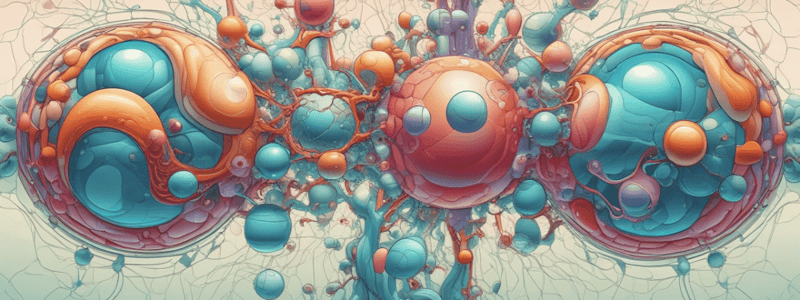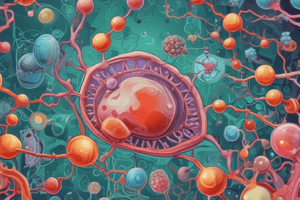Podcast
Questions and Answers
What is the primary function of triacylglycerols in the body?
What is the primary function of triacylglycerols in the body?
- Precursor for vitamin D synthesis
- Hormone synthesis
- Membrane structure component
- Energy storage (correct)
What is the difference between saturated and unsaturated fatty acids?
What is the difference between saturated and unsaturated fatty acids?
- Saturated fatty acids are shorter in length, while unsaturated fatty acids are longer
- Saturated fatty acids have no double bonds, while unsaturated fatty acids have one or more double bonds (correct)
- Saturated fatty acids have a double bond, while unsaturated fatty acids do not
- Saturated fatty acids are found in plants, while unsaturated fatty acids are found in animals
What is the function of bile acids in the body?
What is the function of bile acids in the body?
- To facilitate the digestion of fats (correct)
- To store energy
- To regulate hormone production
- To synthesize vitamins
What is the term for a fatty acid with more than one double bond?
What is the term for a fatty acid with more than one double bond?
What is the term for a fatty acid that cannot be synthesized by the human body and must be obtained through the diet?
What is the term for a fatty acid that cannot be synthesized by the human body and must be obtained through the diet?
What is the term for the ester of glycerol and three fatty acids?
What is the term for the ester of glycerol and three fatty acids?
What is the definition of a lipid?
What is the definition of a lipid?
What is the notation Δ9 in oleic acid (18:1 Δ9) indicating?
What is the notation Δ9 in oleic acid (18:1 Δ9) indicating?
What is the effect of a double bond on the ability of fatty acids to pack together?
What is the effect of a double bond on the ability of fatty acids to pack together?
What is the main component of membranes?
What is the main component of membranes?
What is the hydrophilic part of phospholipids?
What is the hydrophilic part of phospholipids?
What is the common name for phospholipids with choline as the head group?
What is the common name for phospholipids with choline as the head group?
What is the characteristic of glycolipids?
What is the characteristic of glycolipids?
What is the function of ceramide in lipids?
What is the function of ceramide in lipids?
What is the characteristic of sphingomyelin?
What is the characteristic of sphingomyelin?
What is the function of the terminal sugar in glycolipids?
What is the function of the terminal sugar in glycolipids?
Flashcards are hidden until you start studying
Study Notes
Lipid Structures
- Lipids are insoluble in water but soluble in fat and organic solvents.
- Biological functions of lipids include energy storage, precursors for vitamins and steroid hormones, bile acids, and membrane structure.
Fatty Acids (FA)
- Long-chain aliphatic carboxylic acids.
- Can be either saturated (e.g. myristic acid, palmitic acid, stearic acid) or unsaturated (e.g. oleic acid, polyunsaturated fatty acids (PUFA) with more than one double bond).
Triacylglycerols (TAG)
- Ester of three fatty acids and glycerol.
- Stored in adipose tissue.
- Function: energy storage.
Phospholipids
- Composed of glycerol, two fatty acids, and a phosphate-containing head group.
- Different classes of phospholipid depending on the nature of the head group.
- Major component of membranes.
- Head group and phosphate are hydrophilic, while fatty acids are hydrophobic.
- Examples: Phosphatidylcholine (PC), Phosphatidylserine (PS), Phosphatidylethanolamine (PE), and Phosphatidylinositol (PI).
Glycolipids
- Composed of glycerol, two fatty acids, and a head group containing sugars.
- Different classes of glycolipid depending on the sugars present.
- Specialized part of membranes.
- Often have monosaccharide or oligosaccharide chains, with terminal sugar often being sialic acid.
Sphingolipids
- Replace glycerol with sphingosine.
- Ceramide is formed when sphingosine is combined with a single fatty acyl chain.
- Found in some phospholipids (e.g. sphingomyelin) and glycolipids (e.g. GM1 ganglioside).
- Sphingomyelin is present in high amounts together with cholesterol in lipid rafts and in the membranes of myelin sheaths of neurons.
Studying That Suits You
Use AI to generate personalized quizzes and flashcards to suit your learning preferences.




